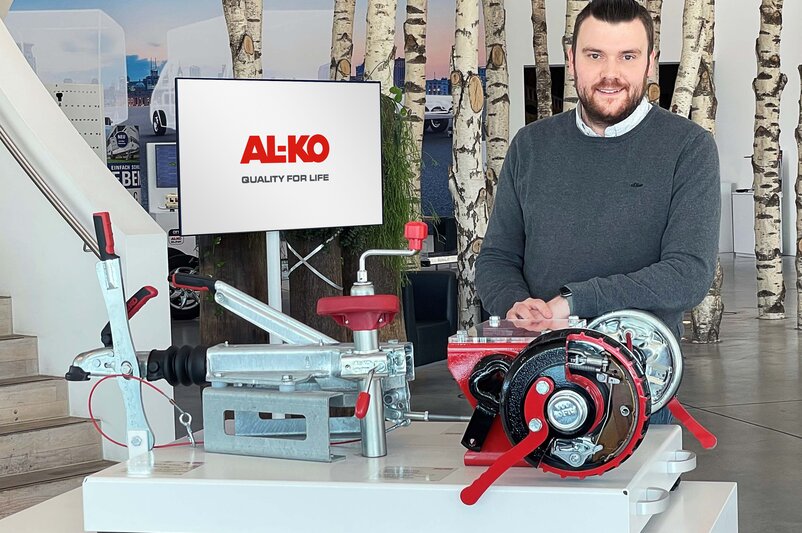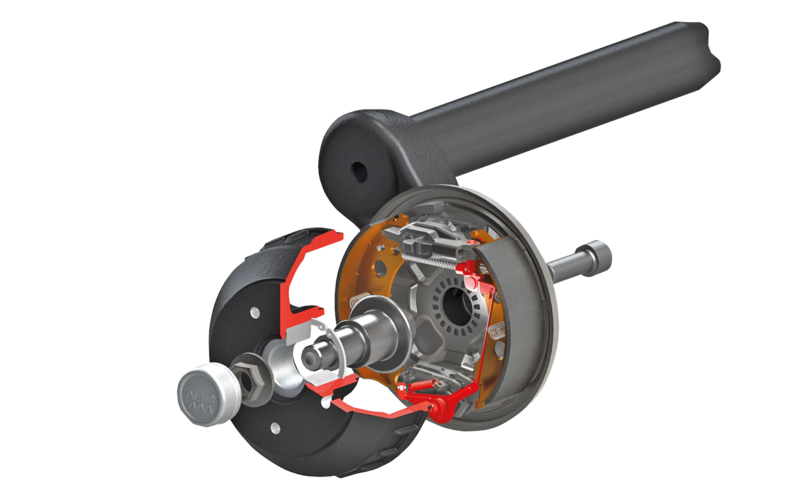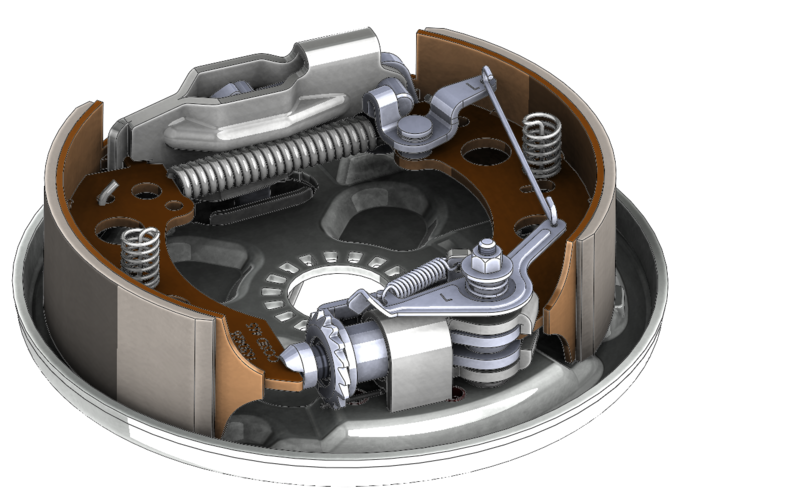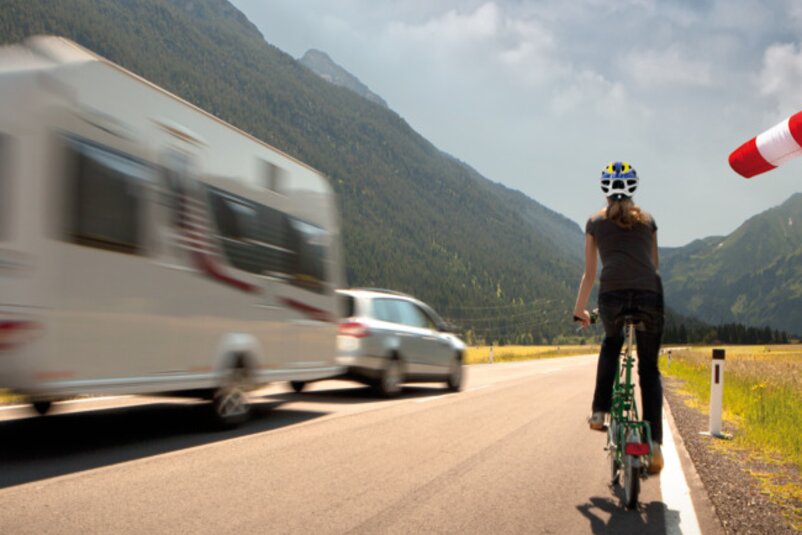How to get the most out of drum brakes
- Properly maintained brakes absorb 70% of the attached load
- The technology is simple, safe and easy to maintain
- Maintenance intervals every 5,000 kilometres or once a year are sensible


"Die Technik der Trommelbremse ist einfach und kostengünstig. Und mit einwandfrei gewarteten Trommelbremsen wird der nächste Urlaub mit Sicherheit ein Erlebnis."
Simple technology, welcome everywhere
The drum brake is still the measure of all things for caravans and light commercial trailers. Several million are in use every day worldwide. Some essential information from AL-KO experts will help caravan beginners in particular to get the best out of them for thousands of miles, both on- and off-road.
Drum brakes can take a lot of rough and tumble. Due to their largely closed housing, practically no dirt gets onto the brake shoes, even when driving on difficult terrain. As Florian Vorreiter from the AL-KO Academy at the AL-KO Vehicle Technology Group knows: “Salt water, falling rocks, gravel, grit, dust: none of this will affect the solid metal drum. The brake shoes themselves are well protected inside the drum.” That's why they are unaffected by the long parking times typical of caravans as well.
Properly maintained brakes have just 0.5 to 1 mm distance, called ‘clearance’, between the brake pad and the drum wall. If the driver in the towing vehicle activates the brake with their foot, the trailer pushes up and thereby presses into the drawbar tube located in the overrun device. This force is transmitted to the drum brakes in the caravan via a relay lever, brake rod and Bowden cables. The brake shoes are pressed outwards, overcome the clearance and rub against the inside of the drum. Vorreiter says: "The relay lever ensures that the Bowden cables have to move three to four millimetres to overcome the actual clearance." Caravan drum brakes usually brake about half of the towed unit's weight and thus relieve the towing vehicle's brakes considerably. "Properly maintained AL-KO brakes absorb almost 70 percent of the attached load," says Vorreiter. If the driver releases the brake pedal at the front, the drawbar tube is pulled out of the overrun device and the Bowden cables are released. In addition, return springs bring the brake shoes back to their original position.
Drum brakes resist adverse environmental conditions just as robustly as they cope with travelling many thousands of miles. They are considered low-wear. “The entire technology is simple, safe and easy to maintain,” says Vorreiter. “If you haven't made it to the workshop before your trip, practically any motor vehicle specialist at home or abroad will be able to help – and when you’re far from home, that's a big advantage.” Adjusting brakes, removing wear and tear, changing pads, checking and renewing lubrication points: none of this poses a challenge for workshop professionals.
Carry out maintenance more often to save money
Wer den Trommelbremsen eines Caravans etwas Gutes tun will, der nimmt die vorgeschriebenen Wartungsintervalle ernst. Alle 5.000 Kilometer oder einmal im Jahr sollte Fachpersonal die Bremsen durchschauen. Der wichtigste Teil der normalen Wartung besteht darin, die Komponenten zu säubern, den Bremsstaub in der Trommel fachgerecht abzusaugen und zu entsorgen, bevor er bewegliche Teile zusetzt. Ebenso sind bewegliche Teile gängig zu machen und vor allem die Bremsen richtig einzustellen. „Das alles ist in der Werkstatt schnell erledigt und verhindert zuverlässig Folgeschäden“, sagt Vorreiter. „Fällt die Wartung aus, kann statt einfachem Reinigen schnell der Wechsel von Komponenten nötig werden – was dann leicht deutlich teurer wird. Grundsätzlich können zu hohe Temperaturen dazu führen, dass die im Belag gebundenen Harze ausgasen und die Beläge ‚verglasen‘. Wenn die Beläge beschädigt sind oder mit weniger als zwei Millimeter Belagstärke an der dünnsten Stelle die Verschleißgrenze erreicht ist, sollten sie achsweise getauscht werden.“
Do not brake in new pads with intensive braking
In addition to regular appointments at the workshop, there is also the inspection prescribed by AL-KO after driving the first 500 kilometres, after a pad change or for new vehicles. Vorreiter says: “For the first kilometres, the coating surface and the drum do not fit together one hundred percent. The friction pairing has to settle in first.” Nevertheless, drivers should avoid ‘hard’ braking, especially on those first trips. “In the beginning, the friction energy is not yet optimally distributed over the entire coating surface. In extreme cases, partial surfaces that make first contact during braking can overheat. Vitrified patches may then appear on the pads. This can also lead to the brake no longer being able to deliver its full performance.” Breaking in the pads therefore means driving carefully, avoiding heavy braking and long mountain passes if possible. If a pass cannot be avoided, it is best to plan for cooling breaks.
Check the pad thickness yourself, but leave any adjustment to the workshop.
When it comes to inspecting the pads, vehicle owners can get involved themselves. There are two plastic dust caps on the inside of the brake drum. One of these reveals one of the brake pads. This should be at least two millimetres thick. If it is thinner than this, a prompt appointment with your trusted workshop is due. Vorreiter says: “Those who attend regular maintenance appointments do not need to worry about this issue. The pros have enough experience to decide whether the existing pads can weather the next big trip or whether a replacement is due.” The clearance can be adjusted behind the other cap. Brake expert Vorreiter can only advise against the often discussed possibility of adjusting the clearance yourself by feeling around with a screwdriver: “The locking ring can be twisted with a screwdriver until the wheel is fixed. But it should be gauged whether it then takes four, six or even twelve detents to get the right distance between the pad and the drum wall.” Professionals can see immediately whether the pads are damaged or ground down on one side during their checks. “You also have to check that if you want the brakes to be adjusted properly,” says Vorreiter.
Noises are not a problem
New drum brakes may emit a gentle grinding sound when the wheel turns without braking. Noises when braking are completely normal. Noises range from scratching and rubbing to squeaking in different frequency ranges. Vorreiter says: “The metal drum and the brake back plate resonate easily and amplify the noise inside. A damp environment in particular can cause noise when braking for the first time after a long time parked up.” However, strong persistent squealing or noticeable grinding can be more than just annoying background noises. Vorreiter says: “They can be an indication that the next workshop appointment is due.”
Operating temperature and anticipatory driving
Drum brakes work best at a brake temperature of 100 degrees Celsius. Vorreiter says: ”200 to 300 degrees is quite acceptable on mountain routes and after several successive braking actions. Anything above 400 degrees is too much.” Heavy grinding – caused by a broken return spring, heavy abrasion not eliminated because of missed maintenance, or vitrified, damaged pads – can lead to overheating. Continuous light braking on mountain routes can have a very similar effect. “Grinding heats up the brake,” says Vorreiter. “With such continuous stress, the airstream and radiation can no longer dissipate the heat quickly enough.” At extreme temperatures, pads can vitrify and even break. Vorreiter says: “In extreme cases, braking performance can be reduced. And at very high temperatures, the grease in the wheel bearing can also lose its effectiveness.”
Skilful driving, clever maintenance
If you are wondering whether one of your brakes actually did overheat on its last drive, it is almost impossible to tell afterwards. Indications are dark spots on the rim, white annealed drums and brake back plates or even the small plastic covers on the back of the brake plate, which melt at around 300 degrees. Vorreiter says: “Temperatures of 300 or 400 degrees are very theoretical values. In practice, very few people have a suitable measuring device with them, especially since it depends on the temperature inside the brake and how long it stays at that temperature.” To reliably avoid overheating, drivers should brake harder and less often, especially when driving downhill. If the route allows it, it can also be useful to accelerate in between to stretch out the vehicle combination again. This prevents so-called dragging, i.e. the permanent grinding and overheating of the pads. In any case, it is important to adjust your speed by thinking ahead.
Drivers should bear in mind that many modern towing vehicles activate an engine brake automatically. “This means that the vehicle brakes without you putting your foot on the brake yourself. But for the trailer, every deceleration of the towing vehicle means more braking.” This can put the brakes in the trailer under stress. So on longer downhill routes, a cooling break can be quite useful – and is a good excuse to treat yourself to a coffee every now and then. The caravan should definitely be given regular maintenance appointments in the run up to the big trip. Vorreiter says: “The drum brake technology is simple and cost-effective. And with properly maintained drum brakes, the next holiday is sure to be a safe and enjoyable experience.”
Sicher bremsen, entspannt ankommen!
Bremsen sind das Herzstück der Sicherheit beim Caravanfahren. Unser Serviceleiter Florian Vorreiter zeigt in zwei Videos gemeinsam mit Dennis von Gogo4Camper, worauf es ankommt:
- Wartungstipps für zuverlässige Bremsen
- Richtiges Bremsverhalten in schwierigen Fahrsituationen
- Mehr Sicherheit und Kontrolle auf jeder Strecke



